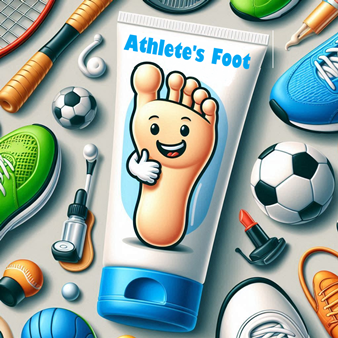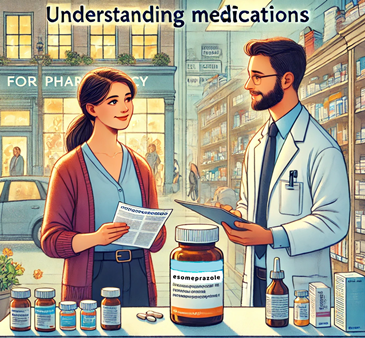by Chris Whitehead
Share

A Foot to Stand On: A Journey to Finding the Right Medication for Athlete's Foot
Jake had been battling a persistent itch between his toes for weeks. At first, he thought it was just dry skin, but the red, scaly patches and constant burning sensation told a different story. As a gym enthusiast, he knew the culprit: athlete's foot. Frustrated and desperate for relief, Jake decided to take matters into his own hands.
He started with an over-the-counter cream he found at the local drugstore. The label promised fast relief, but after a week of diligent application, the symptoms persisted. Next, he tried a different cream, one his friend recommended, but it only made the itching worse. Determined, Jake began to feel like he was fighting a losing battle against the invisible enemy on his feet.
One afternoon, Jake walked into a nearby pharmacy, his spirits dampened but hopeful. He approached the counter, where a friendly pharmacist named Sarah greeted him.
"Hi there, how can I help you today?" Sarah asked, noticing Jake's weary expression.
Jake sighed. "I've tried everything for this athlete's foot, but nothing seems to work. I'm not sure what I'm doing wrong."
Sarah nodded understandingly. "Athlete's foot can be stubborn. Let's figure out the best approach for you. What have you tried so far?"
Jake listed the creams he'd used, describing the lack of progress and the worsening irritation with one of them.
"Sounds like you've tried some topical azoles like clotrimazole and miconazole," Sarah said. "They work for many people, but sometimes a different type of antifungal is needed. Have you tried terbinafine?"
Jake shook his head. "No, I haven't. Is it different?"
"Yes," Sarah explained. "Terbinafine is an allylamine. It works by inhibiting an enzyme that the fungus needs to grow. It's known for its effectiveness and shorter treatment duration. Let me show you where it is."
Sarah led Jake to the appropriate aisle and pointed out the terbinafine cream. "Apply this once daily to the affected area, and make sure to cover a bit of the surrounding skin as well. Keep your feet clean and dry, change your socks regularly, and avoid wearing tight, non-breathable shoes."
Jake thanked Sarah and bought the cream, feeling a renewed sense of hope. That evening, he carefully followed Sarah's instructions, applying the terbinafine cream to his feet. The coolness of the cream provided immediate relief, and within a few days, he noticed a significant improvement. The redness began to fade, the itching subsided, and the burning sensation was almost gone.
After two weeks of consistent use, Jake's athlete's foot had all but disappeared. He returned to the pharmacy to share the good news with Sarah.
"Sarah, it worked! The terbinafine cream did the trick," Jake exclaimed, a broad smile on his face.
"I'm so glad to hear that, Jake," Sarah replied, sharing in his relief. "Sometimes, it's just about finding the right medication. Keep up with the good hygiene practices to prevent it from coming back."
Jake left the pharmacy with a spring in his step, grateful for Sarah's guidance. He had finally found the right medication for his athlete's foot, and with it, a newfound appreciation for the expertise of his pharmacist.
A Pharmacist's Guide to Medications for Athlete's Foot
Athlete's foot, also known as tinea pedis, is a common fungal infection affecting the feet. It is caused by dermatophytes, which thrive in warm, moist environments like shoes and locker rooms. As pharmacists and pharmacy technicians, it is essential to be knowledgeable about the medications used to treat this condition, their mechanisms of action, side effects, and commonly prescribed options.
Mechanism of Action
- Antifungals: The primary treatment for athlete's foot involves antifungal medications, which target and eradicate the fungi causing the infection.
- Azoles (e.g., Clotrimazole, Miconazole): These medications inhibit the synthesis of ergosterol, an essential component of fungal cell membranes. By disrupting ergosterol production, they weaken the cell membrane, leading to cell death.
- Allylamines (e.g., Terbinafine, Naftifine): These agents inhibit squalene epoxidase, an enzyme involved in ergosterol synthesis. This leads to an accumulation of squalene, which is toxic to the fungal cells, and a reduction in ergosterol, compromising cell membrane integrity.
- Benzylamines (e.g., Butenafine): Similar to allylamines, benzylamines also inhibit squalene epoxidase, disrupting the fungal cell membrane.
Side Effects
Understanding potential side effects helps in counseling patients and managing therapy effectively:
- Topical Antifungals:
- Local irritation
- Burning sensation
- Pruritus (itching)
- Erythema (redness)
- Contact dermatitis
- Oral Antifungals (less commonly used but important for severe or recalcitrant cases):
- Gastrointestinal disturbances (nausea, vomiting, diarrhea)
- Headache
- Hepatotoxicity (requires liver function monitoring)
- Taste disturbances
- Rash
Commonly Prescribed Medications
- Topical Azoles:
- Clotrimazole (Lotrimin AF): Available OTC, applied twice daily.
- Miconazole (Desenex, Micatin): Also OTC, applied twice daily.
- Topical Allylamines:
- Terbinafine (Lamisil AT): Available OTC, applied once or twice daily. Known for its shorter treatment duration.
- Naftifine (Naftin): Prescription only, typically applied once daily.
- Topical Benzylamines:
- Butenafine (Lotrimin Ultra): Available OTC, applied once daily.
- Oral Antifungals:
- Terbinafine (Lamisil): Prescription only, typically used for 2-6 weeks. Effective but requires monitoring for liver function.
- Itraconazole (Sporanox): Prescription only, used in pulse dosing or continuous therapy. Also requires liver function monitoring.
Counseling Points for Patients
- Adherence: Emphasize the importance of completing the full course of treatment, even if symptoms improve.
- Application: Instruct patients to apply topical medications to clean, dry skin and extend the application slightly beyond the affected area.
- Hygiene: Encourage practices such as keeping feet dry, changing socks regularly, and wearing breathable footwear to prevent reinfection.
- Monitoring: Advise patients on what side effects to expect and when to seek medical attention, particularly if using oral antifungals.
Conclusion
As pharmacists and pharmacy technicians, our role in managing athlete's foot extends beyond dispensing medications. We must provide comprehensive care, including education on proper use, adherence, and preventive measures. By doing so, we can help our patients achieve effective and lasting relief from this common but bothersome condition.





